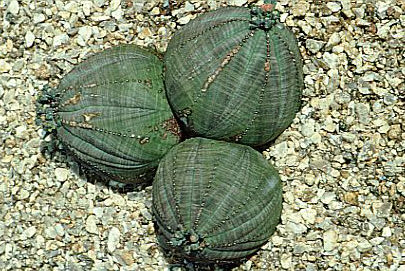Euphorbia obesa
gingham golf ball
A cactus-like succulent to 15cm, with a squat globose or pear-shaped, grey-green stem with 5 ribs, with a pattern of dull reddish bands, and terminal clusters of small yellow flowers in summer

Buy this plant
Size
Ultimate height
0.1–0.5 metresTime to ultimate height
10–20 yearsUltimate spread
0.1–0.5 metresGrowing conditions
Moisture
Well–drainedpH
Acid, Alkaline, NeutralColour & scent
| Stem | Flower | Foliage | Fruit | |
| Spring | ||||
|---|---|---|---|---|
| Summer | Yellow | |||
| Autumn | ||||
| Winter |
Position
- Full sun
Aspect
South–facing or North–facing or West–facing or East–facing
Exposure
ShelteredDrought resistance
Yes Hardiness
H1CBotanical details
- Family
- Euphorbiaceae
- Native to GB / Ireland
- No
- Foliage
- Evergreen
- Habit
- Clump forming
- Potentially harmful
- Humans/Pets: IRRITANT to skin/eye, harmful if eaten. Wear gloves and other protective equipment when handling. For further information and contact numbers regarding pets, see the HTA guide to potentially harmful plants
- Genus
Euphorbia can be annuals, perennials, shrubs or succulents, with milky sap and small flowers held within cupped, often colourful bracts
- Name status
Correct
- Plant range
- South Africa (Cape)
How to grow
Cultivation
Grow under glass in a mixture of three parts loam to one part grit, in full light. Water moderately when in growth and apply a dilute low nitrogen fertilizer monthly. Keep dry in winter. Ventilate well. See houseplant cacti and succulent cultivation for further details
Propagation
Propagate by division
Suggested planting locations and garden types
- Houseplants
- Patio and container plants
- Low Maintenance
- Conservatory and greenhouse
Pruning
No pruning required
Pests
May be susceptible to mealybugs
Diseases
Generally disease-free
Get involved
The Royal Horticultural Society is the UK’s leading gardening charity. We aim to enrich everyone’s life through plants, and make the UK a greener and more beautiful place.